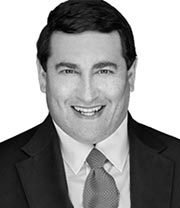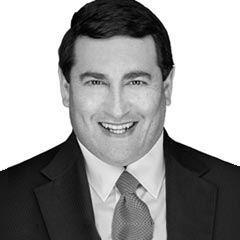



Cameron Fisher
Director of Changing Places Real Estate

Konrad Bobilak
Director of Investors Prime Real Estate

Stephen McClatchie
Director of Loans Australia

James Black CPA Director of Brandi & Co Accounting

Michael Eagar
General Manager of Advice / Senior Financial Adviser at United Global Capital

Debunks one of the greatest retirement myths and flaws in our beliefs given to us by our parents, teachers or loved ones, that: "If you work hard all your life, pay your taxes, and save some money, with the help of the government you will have enough money to enjoy a comfortable retirement."
Discover why government initiatives aimed at boosting superannuation contributions may face challenges in achieving desired outcomes, particularly for many Baby Boomers who may already be at a disadvantage due to timing. Gain insights on strategies to help secure a comfortable retirement and effectively manage your funds over the long term.
Exposes what Fund Managers don't want you to know about your superannuation fund; and what 'Key' investments they are desperately wanting to hide from the Australian public, that happen to be those the 'Rich' have been investing in for decades.
Exposes the best and worst superannuation fund performers over the last 30 years in an industry report compiled by independent industry analysts, SuperRatings. Find out which funds you should stay clear of to avoid poor performance and miss the opportunity of having a comfortable retirement. You will be shocked to learn that this report includes some of Australia's most used Superannuation Funds.
Will Explore How To Capitalise on legislation that will enable you to leverage and tap into high-growth assets that are unavailable as investments through your traditional industry and retail superannuation funds.
Will Uncover how you can easily and effortlessly take control of your superannuation fund, AND how you may be entitled to access some of the $16 billion dollars of missing unclaimed superannuation money. Our easy-to-follow ‘5 Step’ system about checking for lost super will make this process a breeze.
Discover a straightforward '7 Step' system designed to empower you in managing your superannuation fund and making independent investment choices, free from reliance on Fund Managers. Additionally, gain exclusive access to knowledgeable and licensed financial advisors who can guide you in establishing your own Self-Managed Superannuation Fund (SMSF), offering valuable expertise and support along the way.
Will Reveal sneaky but completely legal loopholes of how Australian business owners can use their Superannuation funds to buy a commercial property, and lease it back from their super fund, whilst maximising their tax savings. It’s shocking how many Accountants are completely unaware of this strategy! Hope you’re not one of their clients!
Discover the 'Top 10’ best-performing capital growth suburbs in Melbourne, as well as the ‘Top 10’ worst-performing suburbs by CoreLogic. Furthermore, you will discover the advantages and drawbacks of investing in different types of properties, ranging from established property, off-the-plan, new house and land estates, apartments, townhouses, and detached houses.
Discover the '10 Key Advantages and Disadvantages’ of having a SMSF, and how it can get you close to retiring with a nest egg of $1 million dollars; and why it's essential that every Australian seriously considers these before it is too late.
Most of us daydream about the day we finally finish work and retire. Whether you dream of cruising around the world, camper-vanning around Australia, pottering around the garden or improving your golf skills, the magic question is:
When preparing for retirement, a crucial question to consider is: how much money will you need to live a comfortable life?
The answer to this question varies since everyone has different interpretations of what "comfortable" means. It could entail enjoying a weekly meal at a restaurant or going on an annual vacation. Lifestyle preferences are highly personal, and what one person considers luxurious may be viewed as modest by another.
To provide guidance, the Association of Superannuation Funds of Australia (ASFA) has established a standard called the "retirement standard." This standard outlines the yearly amount required to support both a comfortable and a modest lifestyle during retirement, and it is adjusted quarterly to account for inflation.
ASFA defines a "modest" lifestyle in retirement as slightly above the Age Pension level, allowing retirees to afford basic health insurance, infrequent exercise, leisure activities, and social interactions with loved ones.
On the other hand, the "comfortable" retirement standard enables retirees to maintain a high quality of life. It covers essential daily expenses like groceries, transportation, and home repairs, as well as private health insurance. It also accounts for a variety of exercise and leisure activities, occasional restaurant meals, and the ability to stay connected with family and friends through technology. Moreover, it includes an annual domestic trip and an international trip every seven years to enhance the retirement experience.
Both standards assume that retirees own their homes outright and are generally in good health.
Now, let's delve into what a comfortable retirement truly entails….
According to the Association of Superannuation Funds of Australia’s Retirement Standard, to have a "comfortable" retirement, single people will need $595,000 in retirement savings, and couples will need $690,000. You can use this guide to estimate how much money you’ll need to have a ‘comfortable’ or ‘modest’ retirement. See the box below for more information.


The Standard is updated four times a year to take into consideration the rising price of items like food and utility bills, as well as changing lifestyle expectations and spending habits. The Standard includes the cost of things such as health, communication, clothing, travel and household goods.
Did you know we’re now spending more and more time retired!? According to the ABS 30 years ago the life expectancy for males was 74 and for females 80…that figure has now jumped up to 81 for males and 85 for females…so just imagine what the life expectancy will be in the next 30 years! You might need a lot more money for your retirement than you first thought!

If it isn’t concerning enough that inflation is eroding your retirement income, and what is considered a "comfortable retirement" isn’t what many of us would consider comfortable, let alone our DREAM retirement lifestyle…
You see, most of us are completely oblivious to the severity of the superannuation shortfall that is facing us, and sadly, many Australians leave it far too late to take control of their finances. When they finally do wake up to the grim reality of living out their retirement years in poverty or an extremely modest lifestyle, it's too late.

As you can see from the above data the average Australian is retiring with a massive shortfall in retirement savings with woman particularly disadvantaged!
But don’t despair, as you don’t have to be one of the statistics; you have a choice, and the best way to make sure that you have a comfortable future is to Design It!
Secure your ticket to attend the 1-day live event called;
You see, while the United States has more millionaires than any other country in the world, Australia has the greatest median wealth per head, significantly ahead of the millionaire-rich US.


Despite this, Australians also experience higher than average levels of relative poverty in retirement (see below graph).
This begs the questions…why does a nation with such high median relative wealth have such a high level of relative poverty for their retirees?

The answer?
For many older Australians, the majority of their wealth is tied up in their family home. Although, according to the Australian Institute of Health & Welfare, 80% of Australians own their own home at retirement and share a strong desire to remain at home throughout retirement, which can make it difficult to release equity. Note the only ways to access equity in your home are:
BUT the amount of money you can get depends on:
To enjoy more good years of life in retirement, adequate resources are required. The Australian superannuation system was designed to supplement the pension with private savings from wage contributions.
While the total superannuation savings required to fund an adequate lifestyle for baby boomers is contested, the introduction of superannuation contributions occurred only part-way through their careers at lower levels…a 3% annual contribution in 1992, followed by the Superannuation Guarantee increasing to 9% by 2002, 9.5% in 2014 and now at 11% with a scheduled rise to 12% by July 2025, this has led to a major shortfall in available assets to fund retirement for many baby boomers who have had a low contribution amount for a majority of their working life.
“If you truly want to become independent of the government, a self-funded retiree, live off superannuation, you’re going to have to put your own money in. The occupational superannuation is not going to do it.”

The 'Bad News' is that if you are reading this right now you have a very high likelihood of falling into the category of not having enough money to sustain a lifestyle that you deserve upon retirement.
Remember, according to ASFA, a couple needs $690,000 in super savings at retirement, while singles need $595,000, in order to achieve a “comfortable” lifestyle.
However, most working age people are not on track to reach that level.
“The reality at the moment is about 20 per cent of people get there,”

The ASFA calculation to reach what it terms a comfortable standard assumes a future pre-tax wage income of just under $65,000 a year and that a couple or single person has no mortgage or rent to pay. The figure also assumes they use up all their retirement fund and receive a part age pension.
And chances are, after a few short years of having exhausted all your superannuation funds, you will become reliant on the government pension and family support, living a life of quiet desperation, and definitely not being able to enjoy your ‘Dream’ retirement let alone a ‘comfortable’ retirement like you deserve after working hard all your life and paying taxes.
The reasons for this shortfall obviously differ from person to person, BUT the reality of it usually boils down to the following four main reasons;
The 2008 recession and the 2020 pandemic are hastening the end of retirement as we now understand it.
The problems of chronic underfunding, longer lives and increasing aged care and medical costs are accelerating. The pressure has been exacerbated by individuals forced to draw on funds during the pandemic.

However, the typical accumulated balance at retirement age is just over $320,000 for men and just under $250,000 for women.
The averages are artificially increased by a small pool of people with large balances but even the “average” balances are well below the $595,000 for single and $690,000 for couples estimated to be necessary for homeowning and debt-free people to finance their retirements, which may last 20 years or more!
These shortfalls force increased reliance on a government-financed pension, originally intended only as a safety net.
When you retire, your salary stops. From that point on, you need to fund your lifestyle using your own savings plus any Age Pension income you might become entitled to.
For very wealthy people this might be easy, even without an Age Pension. For those with very little, it can also be straightforward – if they’re able to live on the Age Pension as this provides them a lifetime income stream.
But for those in between, who we refer to here as ‘middle Australia’, the maths to get this right is really difficult. A key issue is that no one knows how long each retiree will live. It’s therefore not possible to calculate how much someone can safely draw from super – as you don’t know when their balance needs to reach zero!
The following chart illustrates the actual median age of death for all Australian retirees who died during 2020.

If your aiming to retire at 65, given the average life expectancy is currently decades beyond that and is increasing, you could find yourself having to fund many more years of retirement than expected.
Are you worried about how you will be able to achieve this outcome comfortably?
Do you have the exact formula or methodology written down that clearly shows how you will be able to generate enough income in your retirement years?
Or will you be simply relying on the government pension and reverse mortgages against your only asset… your family home?

The 2020 Callaghan Retirement Income Review of the Australian retirement system highlights how retirement arrangements will be forced to evolve.
The centrepiece is the proposition that retirees must live off their savings and the equity in their home, not only the earnings on their investments.
Savings should not be seen as building a legacy or nest egg to be bequeathed to the next generation.
All savings must be exhausted and the family home monetised to fund living standards in retirement. In essence, your account balance should be at zero at the time of your and your spouse’s death.
Given the need for shelter, this will necessitate taking out reverse mortgages (effectively borrowing against the value of the home with the debt to be liquidated on sale at death).
See the 4 reasons why “you will work until you are dead” as highlighted in a Financial Review article by contributor Satyajit Das, Feb 3, 2021.
First, households must borrow when there is no capacity to service debt. The loan and capitalised interest must be recovered from the eventual sale proceeds of the home. This is dependent on asset values. If population cohorts retire and die around the same time, it will place pressure on house prices which secure mortgage loans.
Second, reverse mortgages may not generate sufficient money to finance retirement. It assumes high levels of savings or home equity. This is compounded by the likely low loan-to-value ratio of a reverse mortgage because of the lack of cash interest payments and collateral value uncertainty.
There are difficulties in estimating borrower longevity and partner survival, something which has eluded mankind and actuaries alike. Commercial lenders may be reluctant to participate without government support or guarantees, which would increase the demands on state resources.
Third, the scheme favours existing homeowners. Housing unaffordability means that many in future generations will never own homes. They are simultaneously deprived of bequests from parental estates reducing their seed capital. Given the record numbers of children forced to move back in with parents, the liquidation of the family home may also deprive them of housing.
Fourth, the strategy entails running down the wealth stock of a country as savings are used up and houses sold. In effect, capital is consumed to finance current expenditures. In aggregate, the running down of savings will affect available investment resources across the economy, making the nation more dependent on foreign sources.
Superannuation funds recorded their worst returns in 2022 since the Global Financial Crisis as share markets plunged due to high inflation and rising interest rates.

So that’s the Bad News…
The 'Good News’ is that you don’t need to become a statistic. There is a real solution for you but it all starts with educating yourself about what options are available to you. AND... what industry experts can help you build up a sufficient nest egg to make sure that you have an adequate balance upon your retirement, to enjoy the quality of life that you and your family truly deserve!
The best way to make sure that you have a comfortable future is to Design It!
Secure your ticket to attend the 1-day live event called;
Australians seem to have a love affair with residential property. We love to constantly talk about it, watch it on TV, and follow the market in the media. We attend auctions on the weekends, check property listings in our local weekly magazines, and apart from the tangible aspect associated with real estate (the “I can see it and touch it” phenomena not found with shares, bonds, and term deposits), there are a number of good reasons why so many Australians are flocking to their accountants and financial planners in order to set up their SMSF and snap up a piece of the Australian dream.
The reason behind the popularity of direct residential property has to do with the stability and predictability of the asset class.
Current data from the Real Estate Institute of Australia (REIA), and the Australian Bureau of Statistics (ABS) shows, despite the volatility of the European and US markets, Australian residential property in all the major capital cities has demonstrated a level of resilience that has managed to defy the expectations of the “doom and gloomers” for over three decades.
The table below from CoreLogic Australia depicts median house and unit values for the past 30 years, across the major capital cities in Australia.


That’s some pretty impressive out performance, especially when you take into account the effects of leverage!
But despite the median price rises over the long-term, there have been a number of market corrections and negative growth in the short term, given the cyclical nature of the Australian property market. In fact, CoreLogic Australia has found that there have been six cycles of growth and decline between the years 1992 and 2022.
Hence, it is important to stress there is a level of market volatility in the property market as well, and as a result property investing should always be considered a long term investment.
It’s hard to imagine strong house price growth at a time when real estate values are declining or flat lining in most capital cities, but the numbers tell a different story.
One of property’s most popular sayings, that house prices double every 10 years, is more accurate than you might think.
Despite real estate values falling this year in most cities, a MoneysaverHQ analysis of 40 years of Real Estate Institute of Australia data has found that a majority of state capitals have indeed doubled every decade.
But it hasn’t been a smooth ride, often marked by many years of little growth and then short boom periods.
Since the REIA data series began in 1980, the numbers have been impressive:
Sydney median house prices have doubled four times, up from $64,800 to $1,031,138 — a 1,591 per cent gain.
Melbourne prices more than doubled four times over, up from $40,800 to $751,125 a 1,840 per cent gain.
Brisbane also more than doubled four times, from $34,500 to $705,016.
Adelaide also more than doubling four times from $36,300 to $650,981.
Perth didn’t quite get there, doubling at least three times from $41,500 to $572,837.
Canberra has performed the best of all capitals, doubling almost five times from $39,700 to $839,732.
Smaller cities Hobart and Darwin don’t have REIA records dating back to 1980, but have both doubled at least twice since the late 1980s.
Hobart’s median house price have had an impressive growth doubling three times from $88,000 to $648,811 since 1991, and Darwin is up from $87,500 to $484,483 since 1987.
This has been evident in the latest released data from the Australian Bureau of Statistics. (ABS) showing the combined value of all residential properties in Australia rose by $140.0 billion to $9,874.7 billion this quarter (March 2023).

So, there you have it!
By attending the 1-Day live Master Your Super, Secure Your Future, event you will end up with a 'Superannuation Blueprint', or a step-by-step manual for everything that you need to know about your superannuation fund and its ability and suitability to buy Australian Real Estate.
The range of topics covered in this live 1 -Day workshop range from the rules and legislation that govern superannuation funds, to how to tap into the $16 billion dollars of missing super and find out if any of it is yours (www.findmysupercom.au), to the ongoing costs involved in setting up and managing your Self-Managed Superfund (SMSF), to learning about what loan options are available for your fund to leverage it's returns using direct real estate.
Furthermore, you will walk away with specific information on how you can implement these strategies, including direct contact details of government departments as well as private accounting firms that can help you consolidate, set up, and manage your Self-Managed Super Fund in a compliant way, and take complete control of your future.





Cameron is the Managing Director of Changing Places Real Estate and he has many qualifications that make him a top figure in the real estate market. These qualifications include: fully licensed real estate agent, qualified valuer, over 3,000 successful (and dynamic) auctions, adviser to leading Institutions, accountancy practices, and law firms.
Cameron’s services are used worldwide and his qualifications serve to demonstrate his extraordinary skill set. In this incredibly competitive industry, few can even compare to Cameron. His pioneering approach and upbeat personality make him a perfect choice for those leasing, selling or buying.
The Australian premier of “The Money Game” only offered more proof that Cameron Fisher is by far one of Australia’s elite entrepreneurs. He took on the challenge of going against Australia’s best and conquered it with surgical precision. Never was this more apparent than the challenge in which he was given $10,000 and told to turn it into as much money as he could within 55 hours. Using his impressive skill set, he turned the $10,000 into $65,466 within the 55 hours.
If you are a landlord, or buying or selling a property, then Cameron Fisher should be the only name you are thinking of.
Konrad has educated well over 120,000 Australians on how to successfully build and structure a multi-million dollar property portfolio from scratch that has the potential to replace your income and eventually free you from work!
When it comes to building a property portfolio the “RIGHT WAY” you will know you’re in the best hands. Konrad has extensive experience in Managed Funds, Risk Insurance, Real Estate Sales, Commercial Lending, Residential Lending, and Asset Finance, as well as being a Financier for one of the four major banks. In his variety of roles, working predominantly with high net worth individuals, Konrad has literally had a wealth of exposure to the unique mindset and financial structures of truly successful people and investors. It is his experience and insight that renders him a most astute investor himself, having personally built a multi-million dollar property portfolio in Melbourne and Queensland over the last decade; he truly practices what he preaches.
Konrad’s unique insights into ‘Wealth Psychology’ combined with a highly specialised knowledge of the Finance and the Real Estate Industry in Australia, have made him a sought after Real Estate and Finance ‘Key Note’ speaker and successful real estate investor. Having taught tens of thousands of people in Australia, New Zealand, and Fiji, Konrad has had the unique opportunity of sharing the stage with the likes of Sir Richard Branson, Tim Ferris, and Randi Zuckerberg in audiences of up to five thousand people. Konrad has also been a regular contributor of articles to some of Australia’s leading published real estate investing media.
As the Director of Loans Australia my vision is to create a company with the systems and structures designed to ensure that clients make the most of their finance situation to propel them forward. Having dealt with many investors and business owners with complex financing structures I understand the importance of setting up finance structures that can assist people to build a property portfolio or asset base. I specialise in showing people the most effective ways of mortgage structuring, strategic financing, management and mortgage selection. My passion is to educate people around finance so that the knowledge and know-how of clients is enhanced over time.
Outside of my business I enjoy property investing and have developed my own property portfolio over the last 15 years. I also enjoy spending time with my family, participating in sports such as tennis and cricket, and supporting my football team.
Final Thoughts...
With life expectancy now climbing for those who reach the age of 65, and with actuarial modelling using income of $31,785 a year as the 'modest' benchmark, and $50,004 as a 'comfortable' amount for an individual's needs; many Australians will find themselves falling short of the hundreds of thousands required in order to draw down the 'comfortable' amount each year.
And despite the recent lift in Australia’s compulsory superannuation contributions from the current 11 per cent to 12 percent by 2025, this will sadly come too late for many Baby Boomers in light of the recent stock market volatility and uncertainty, and the economic fallout of Covid-19; who knows how long the losses of 2022 will take to claw back?
The reality for many Baby Boomers is they will be forced to remain at work well into their 70s whilst others will be forced to live a modest existence being reliant on government pensions and family assistance.
Hence, the motivation for creating this amazing 1-Day live Master Your Super, Secure Your Future event is simply to 'empower' and 'inform' everyday Australians about the importance of taking control of their superannuation funds, and having complete control over their financial matters to make sure they have the potential to end up financially independent in their retirement years.

Yours sincerely,
The Team at Master Your Super, Secure Your Future Event.

This website contains general information only and is not intended to provide any person with financial advice. It does not take into account any person’s (or class of persons) investment objectives, financial situation or particular needs, and should not be used as the basis for making any investment or financial decisions.
Super Fund Master Class does not make any representation as to the accuracy, completeness, relevance or suitability of the information, conclusions, recommendations or opinions contained in this article (including, but not limited to any forecasts made). No liability is accepted by Super Fund Master Class or its directors, officers, employees, agents or advisors for any such information, conclusions, recommendations or opinions to the fullest extent possible under applicable laws.
Anyone considering making any investment decisions based on the information contained in this presentation should note that past performance, target returns or estimates of returns is not a reliable indicator of future performance and actual results can vary significantly.